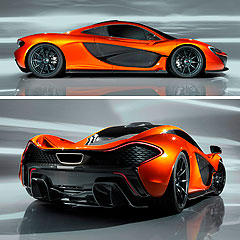Paris show: McLaren reveals P1 flagship
BY HAITHAM RAZAGUI | 19th Sep 2012

The British supercar specialist stated its goal of making the P1 “the best driver’s car in the world on road and track” and confirmed the production P1 will be revealed next year with the aim of bringing it to market within 12 months.
Speculation around the flagship McLaren has centred on an ability to reclaim the title of world’s fastest car from the record-breaking Bugatti Veyron, but McLaren Automotive managing director Antony Sheriff said this was not a priority.
“Our aim is not necessarily to be the fastest in absolute top speed but to be the quickest and most rewarding series production road car on a circuit,” said Mr Sheriff.
“It is the true test of a supercar’s all round ability and a much more important technical statement.
“Our goal is to make the McLaren P1 the most exciting, most capable, most technologically advanced and most dynamically accomplished supercar ever made.”

McLaren Automotive executive chairman Ron Dennis said it was time for McLaren to move the supercar goalposts again, as it did with the 1992 F1 that held the title of world’s fastest car until Bugatti unleashed the Veyron in 2005.
“Twenty years ago we raised the supercar performance bar with the McLaren F1, and our goal with the McLaren P1 is to redefine it once again.”British journal Autocar says sources indicate the P1 will employ a 716kW powertrain aided by a Formula 1-style kinetic energy recovery system (KERS), will cost £800,000 ($A1.25 million) and have a production run limited to 500 units.
Autocar also suggests the P1 will have a modified version of the 12C’s V8 rather than a V12 engine, have a similar footprint to the 12C, retain that car’s everyday usability and be based around its MonoCell carbon-fibre tub-style architecture.
A roof-mounted air scoop and fighter-jet style cab-forward, flat rear deck design reference the original F1 and the P1’s headlights are shaped to mimic the McLaren Automotive emblem.